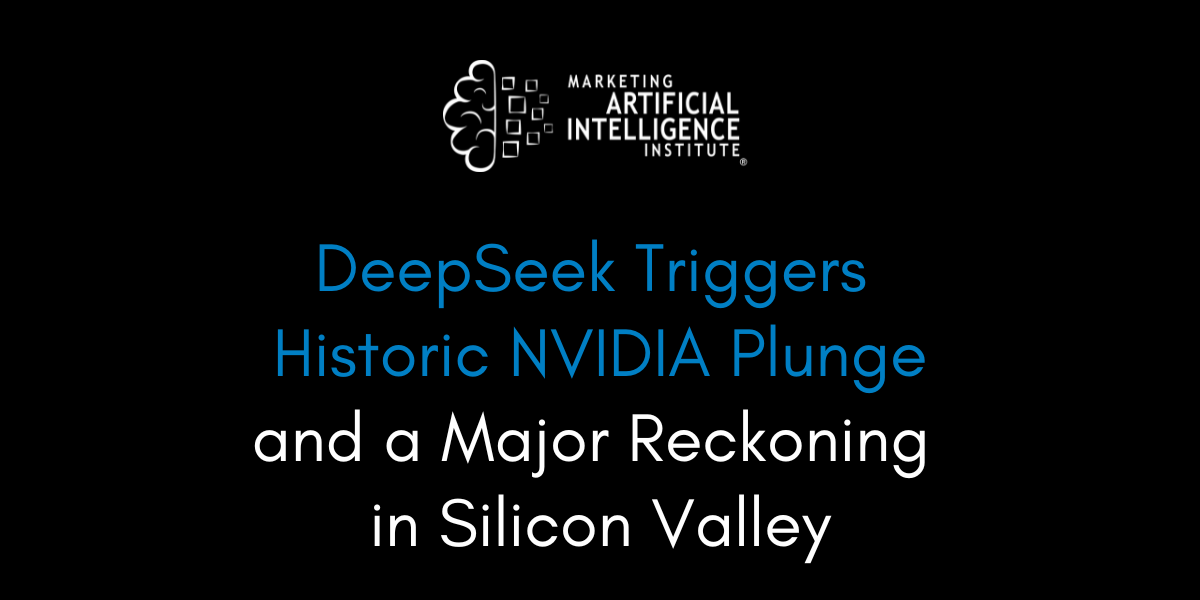On a single day last week, chip giant NVIDIA saw its stock plunge 17%, wiping out an eye-popping $600 billion in market value—reportedly the largest one-day loss ever recorded by a US company.
The cause? DeepSeek, a Chinese AI lab that just released open-weight models it claims rival the performance of those developed by leading AI labs at a fraction of the cost.
Last week on The Artificial Intelligence Show, we covered DeepSeek’s disruptive entry into the AI arms race. On Episode 134, myself and Marketing AI Institute founder and CEO Paul Roetzer unpack the bigger implications of DeepSeek as the dust starts to settle.
Here’s what you need to know.
The Day the Markets Panicked
Almost overnight, DeepSeek’s new V3 model (positioned as a competitor to GPT-4o) and R1 model (rivaling advanced reasoning models) sent the tech sector into a tailspin over a single bold claim:
Headlines screamed from the rooftops that DeepSeek achieved equivalent performance to the best models out there by spending only $6 million on its V3 model, a fraction of the cost required to build GPT-4o and other comparable models.
If DeepSeek really could match the performance of behemoths like OpenAI and Google—and do it for millions of dollars instead of billions—that changes everything. Investors immediately began questioning whether mega-budgets for AI training truly made sense. That caused Nvidia’s massive drop in stock price. Microsoft, Meta, and Google took big hits, too.
But the truth is a little murkier. And Roetzer believes many investors simply reacted too quickly.
“I think it was mostly an overreaction because people didn't really understand what it was or what the implications were,” he says.
Reports have now come out that the $6 million price tag is very likely misleading. Anthropic CEO Dario Amodei, in a new essay, states outright that “DeepSeek does not ‘do for $6M what cost US AI companies billions.’" Headlines equated the $6 million with the total cost of the model. In fact, it was likely the cost of a training run, not the grand total invested in the chips, engineering, and research required to create DeepSeek's V3 model—or any of its other models.
“I think it's pretty safe to say that those media headlines were misrepresenting what was actually going on,” says Roetzer.
Now, that doesn't make DeepSeek less impactful. It's important, just for other reasons.
Sam Altman: “We’ve Been on the Wrong Side of History”
Andrew Ng, co-founder of the Google Brain team and a leading AI authority, took to X to say DeepSeek crystallized some core trends that have been “hiding in plain sight”:
The buzz over DeepSeek this week crystallized, for many people, a few important trends that have been happening in plain sight: (i) China is catching up to the U.S. in generative AI, with implications for the AI supply chain. (ii) Open weight models are commoditizing the…
— Andrew Ng (@AndrewYNg) January 30, 2025
These include:
- China is catching up in generative AI, with serious implications for the global supply chain.
- Open-weight models are commoditizing the “foundation model” layer, creating opportunities for application builders.
- Scaling up hardware isn’t the only path to AI progress—algorithmic innovations are rapidly driving costs down.
OpenAI CEO Sam Altman even admitted to Reddit during an AMA that OpenAI has likely been “on the wrong side of history” regarding open-source efforts—and that the company needs to figure out a new strategy. (However, he did note that open source isn’t the lab’s “highest priority” at the moment.)
Overall, DeepSeek matters because it's injecting even more urgency into the AI arms race. And, it's injecting more uncertainty into that race.
Governments worldwide, notably Ireland and Italy, launched investigations into DeepSeek over data security concerns. Hundreds of businesses also rushed to block access to DeepSeek models, fearing Chinese government influence and uncertain handling of user data.
At the same time, OpenAI and Microsoft are reportedly investigating whether DeepSeek used data “distilled” from OpenAI’s models to train its own. The White House’s AI czar, David Sacks, claims there’s “substantial evidence” that DeepSeek illegally leveraged OpenAI’s systems. (DeepSeek hasn’t directly commented on the accusation.)
If these allegations are true, it raises further questions about the company’s alleged milestones. It also leaves a massive question mark over how well future regulations and guardrails will hold up, especially across international borders.
A New Normal
Ultimately, the big takeaway is that DeepSeek’s breakthrough could spur major players to fast-track releasing even more powerful AI, leading to a new normal where AI releases move even faster.
“I expect that people are going to get used to the Chinese labs putting out advancements and models, doing things more efficiently, and pushing the American labs to maybe release stuff before they would normally be ready,” says Roetzer.
Investors may have overreacted at first, but five years from now, we may well see DeepSeek’s debut as a turning point when competition heated up and open-weight models truly hit the mainstream.
Says Roetzer:
“When we look back, it'll have been a very significant moment.”
Mike Kaput
As Chief Content Officer, Mike Kaput uses content marketing, marketing strategy, and marketing technology to grow and scale traffic, leads, and revenue for Marketing AI Institute. Mike is the co-author of Marketing Artificial Intelligence: AI, Marketing and the Future of Business (Matt Holt Books, 2022). See Mike's full bio.



